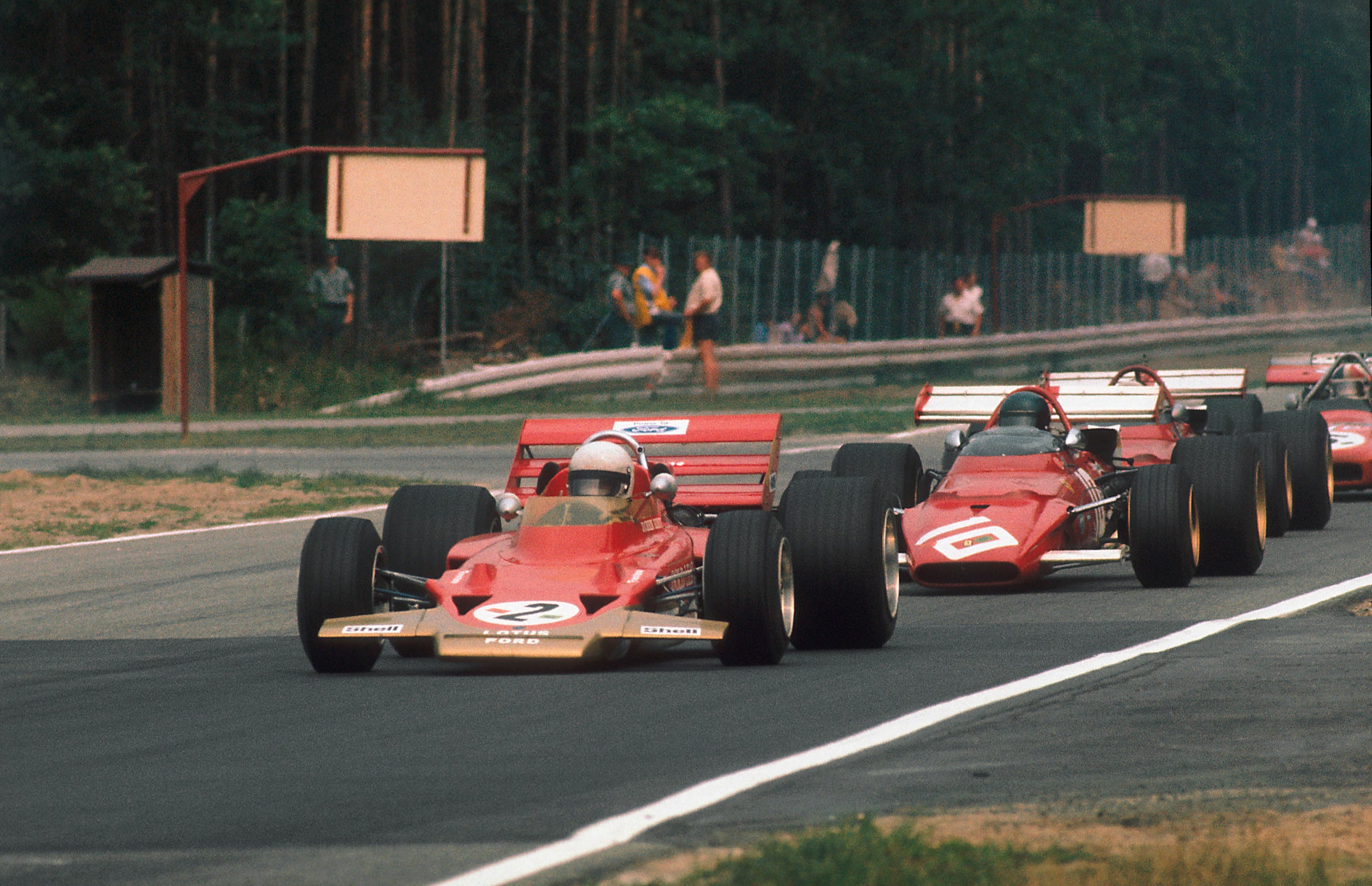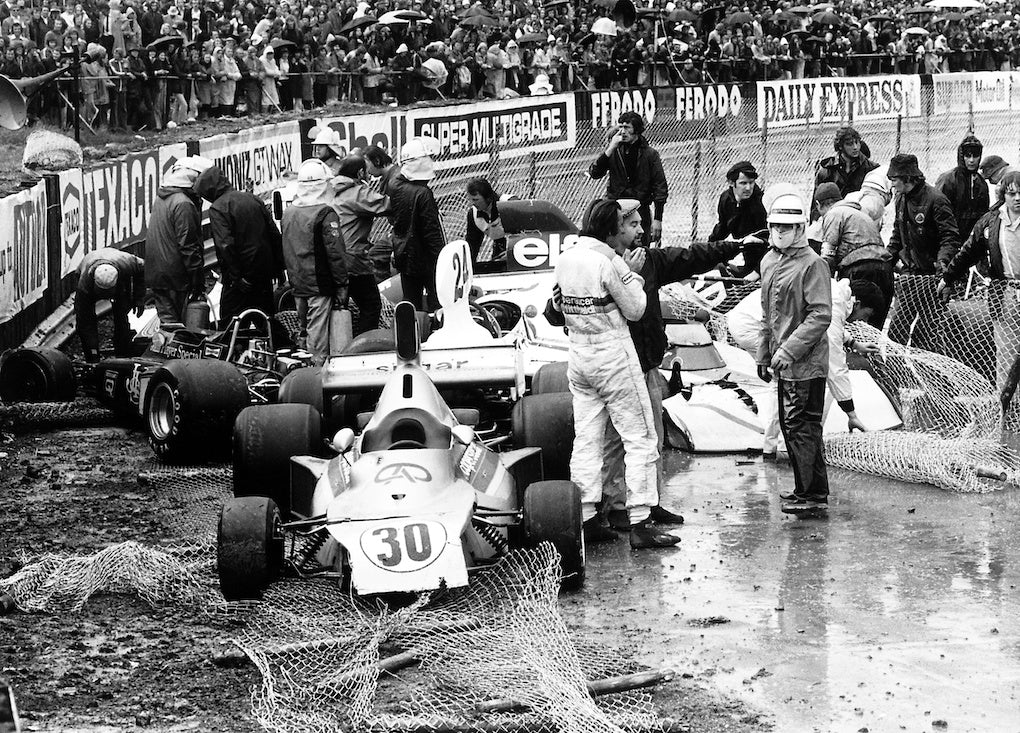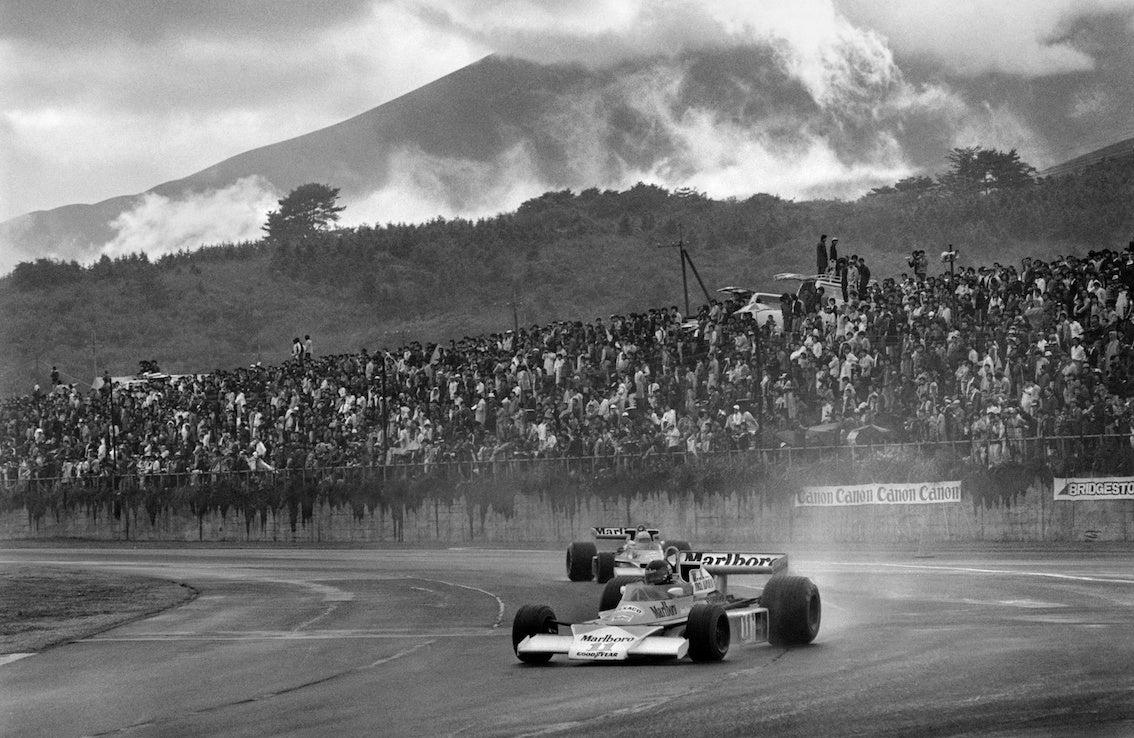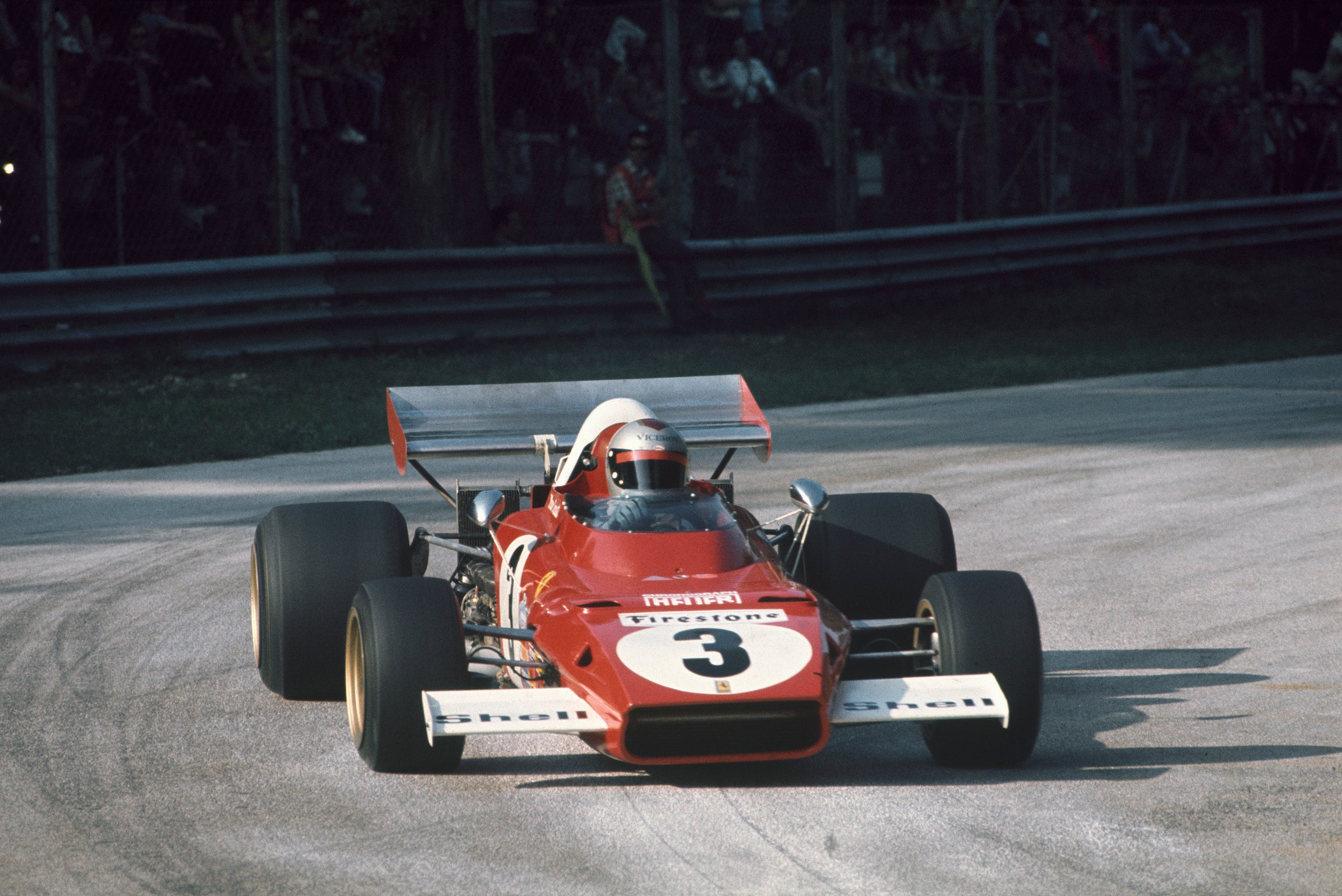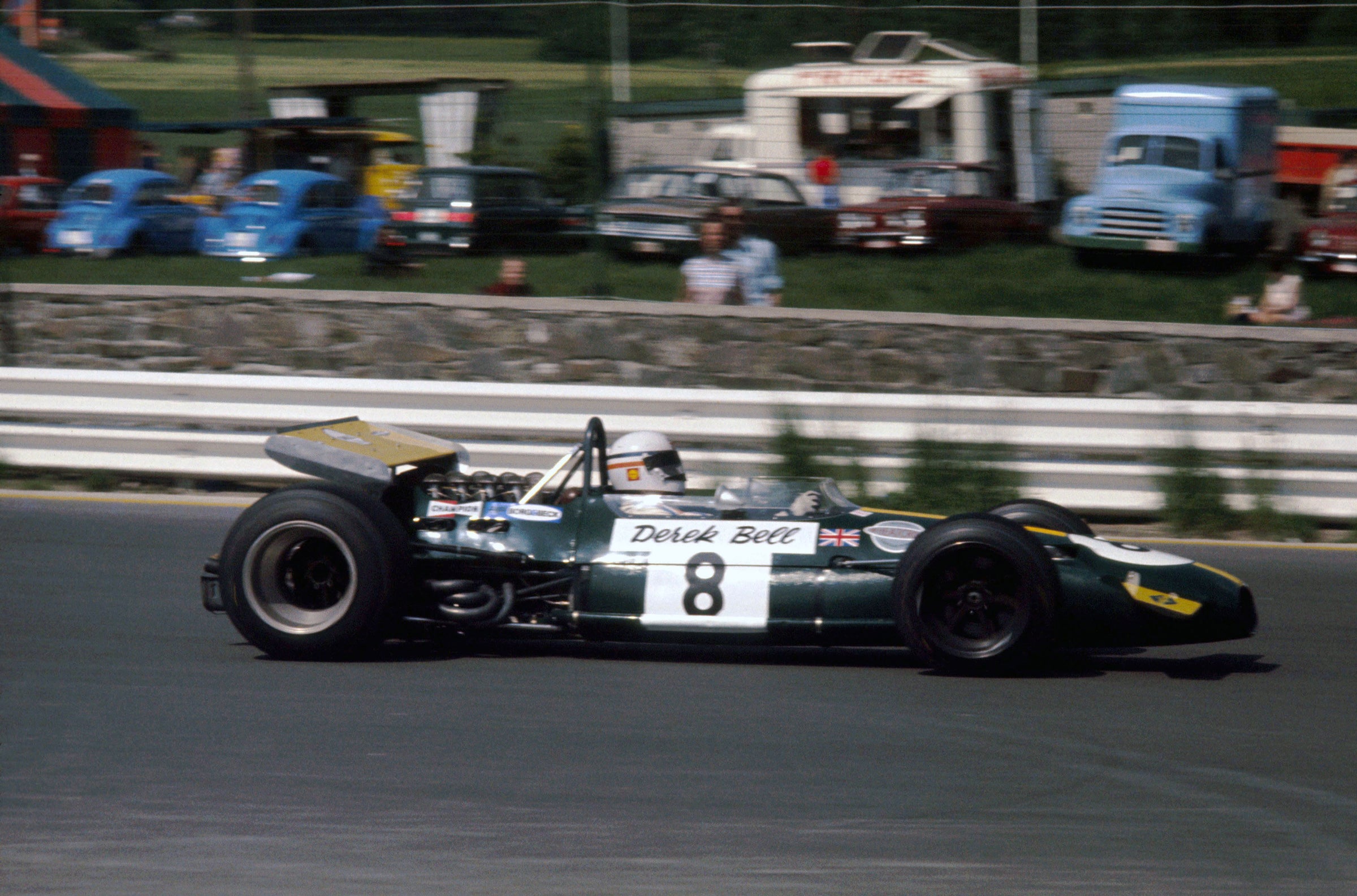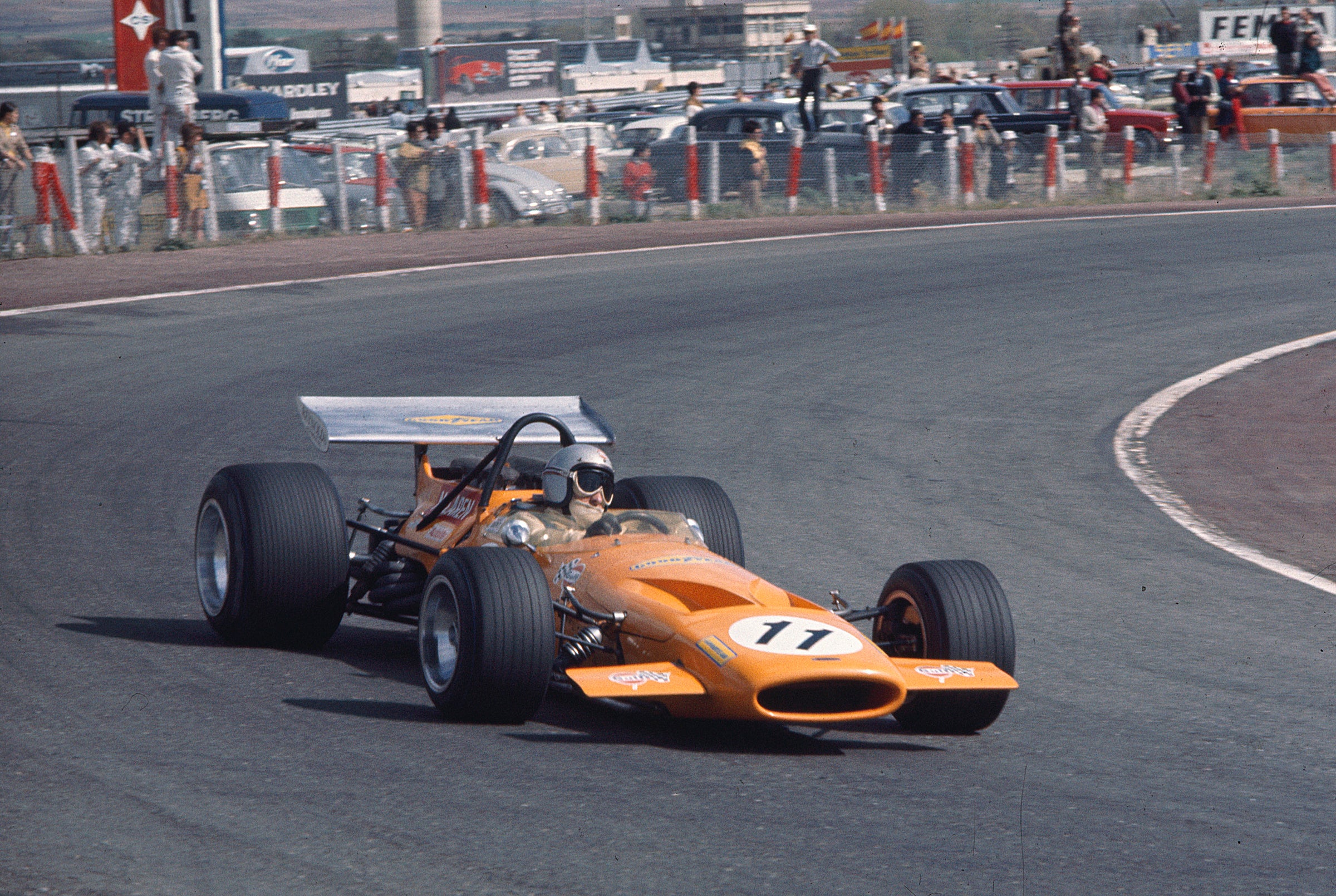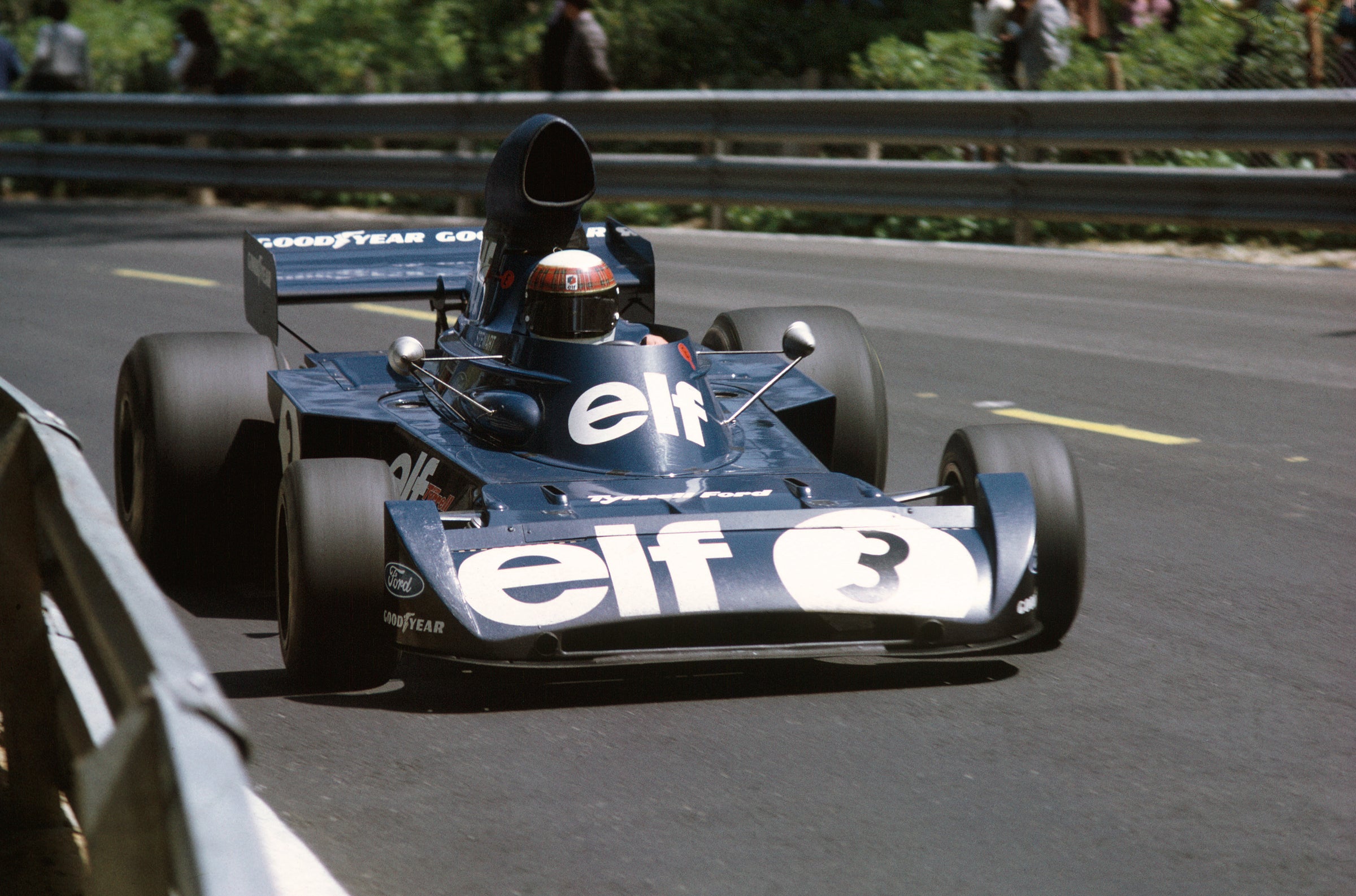Formula 1: Car by Car 1970–79
- In stock, ready to ship
- Inventory on the way
1973
STEWART RETIRES AFTER HIS THIRD TITLE
The deaths of Roger Williamson and François Cevert reinforced the quest for improved safety as poorly secured barriers and fire had contributed to these tragedies. Zandvoort spent £350,000 on circuit improvements but, according to Autocourse, ‘fire-fighting arrangements were woefully inadequate’. The aftermath of the Dutch Grand Prix saw the introduction of new safety measures such as a pace car, a 2x2 starting grid and race stoppage in the event of a serious accident, and BRM’s Louis Stanley headed a new
fire-safety committee.
The Commission Sportive Internationale (CSI) had wanted to reduce the risk of fire by restricting fuel capacity and therefore introducing refuelling. There was even talk of two heats at circuits with inadequate pitlanes. In the end new rules, applicable from the Spanish Grand Prix, stipulated that fuel tanks had to be protected by deformable structures. The minimum weight was raised from 550kg to 575kg.
Formula 1 lurched from one crisis to another during 1972 and 1973, with everyone from the circuits to the press forming a trade union or a committee to argue with each other. The promoters announced Grand Prix International (GPI) on 11 October 1972 with former CSI Secretary Henri Treu directing affairs. The Dutchman spent the coming months negotiating with the F1 constructors about start and prize money. At the Formula One Constructors’ Association (FOCA) the finance committee of Phil Kerr (McLaren), Max Mosley (March) and Bernie Ecclestone (Brabham) wanted a minimum of £103,000 per race while the GPI was prepared to offer £53,000, a 12.5 per cent increase on 1972. The row rumbled on until a month before the season and the CSI even threatened to sanction the World Championship for Formule Libre (F1, F2, F5000 and USAC) if no agreement could be reached. However, the GPI disintegrated when FOCA negotiated with the individual race organisers.
The Grand Prix Drivers’ Association (GPDA) complained that there were too many journalists and photographers in the pitlane at Monaco so the International Racing Press Association (IRPA) was formed with Bernard Cahier at the helm. A new pass system was eventually introduced at Monza (where the sponsors formed their own union).
Political upheaval threatened the Argentine GP until a month before the start of the season. On political grounds the Belgian GP moved to Zolder, where a newly laid track surface broke up dangerously during pre-race testing, leading to delayed practice; sections of new tarmac were laid overnight and it was a relief when the race ended without serious incident. Paul Ricard held the French GP, Sweden appeared on the calendar for the first time, and the British GP was threatened by the starting-money row. Fearing an enforced ban on tobacco advertising in Germany, teams voluntarily removed all such identity there.
On a racing matter, Firestone announced to the American press on 7 September 1972 that it would ‘discontinue its auto racing programme in Europe at the end of the current season… because of greatly escalating costs’, news that came as a surprise to general manager Bob Martin and his team in Brentford. Although the company later reversed its decision for a short period, both Ferrari and Lotus defected to Goodyear.
ELF TEAM TYRRELL
Tyrrell remained unchanged for a third successive season with Jackie Stewart and François Cevert both driving third-generation cars (chassis 006 and 005 respectively). ‘The troubles I have had with my health this season obviously meant that I considered retirement,’ Stewart said on being confirmed in August 1972. ‘Now I am really looking forward to a full season next year.’ Designer Derek Gardner experimented with a Lotus-type wedge-shaped nose during the season and the cars had new driveshafts at the start of the campaign.
Tyrrell was the only team to test at the Autódromo Almirante Brown in Buenos Aires before the Argentine Grand Prix. Cevert led Stewart for much of the closely fought race before both were passed by Emerson Fittipaldi’s Lotus. Cevert finished second with Stewart third despite a slow puncture. The Scot was second in Brazil although Fittipaldi won again to suggest further Lotus domination.
Both drivers crashed at Kyalami’s Crowthorne Corner before the South African GP after brake failures but Stewart rebounded to score his first victory of the season. Restricted to 16th on the grid following his practice accident and having taking over Cevert’s longer 005 chassis for the race, Stewart made a great start and led from lap seven until the end. McLaren protested that he had overtaken Ronnie Peterson under waved yellow flags but Stewart escaped with a reprimand.
He won the International Trophy at a snowy Silverstone but ran out of brakes in Spain, where Cevert finished second, and now trailed Fittipaldi by 12 championship points. Tyrrell bounced back at Zolder with Stewart heading a blue 1–2 despite Cevert spinning out of the lead as the dangerous track surface disintegrated. Stewart equalled Jim Clark’s record 25 GP wins by converting pole position into victory at Monaco. Cevert came from the second row to lead into Ste Dévote but punctured a tyre against a kerb next time round and recovered to finish fourth.
Both drivers were placed in Sweden and France, with Cevert third and second respectively after Stewart was delayed on both occasions. Stewart spun through the infield corn during the British GP before leading further Tyrrell 1–2s at Zandvoort and the Nürburgring. Second in Austria, Stewart clinched his third title by storming through the field at Monza to finish fourth having changed a punctured tyre.
Tyrrell ran a third car in North America with Elf protégé Patrick Depailler announced during the Italian GP weekend. However, the Frenchman upset his sponsors by breaking his leg in a motorcycle accident so it was Chris Amon who drove. Tyrrell’s great season ended in tragedy with Cevert killed during practice at Watkins Glen. The team withdrew as a mark of respect and so finished as runners-up in the constructors’ standings.
There had been constant speculation regarding Stewart’s long-term future and he had made his decision in April. A week after the final race of the season, Stewart announced his immediate retirement from motor racing at the Carlton Towers Hotel near Heathrow.
JOHN PLAYER TEAM LOTUS
Ronnie Peterson was the most sought-after driver in the summer of 1972 and he signed a 60-day option with Lotus at Hethel on 3 July. That news emerged during the Austrian Grand Prix meeting although he assured March’s Max Mosley that it was not binding. Peterson’s legal aptitude was akin to his testing skills, it seems, and he was confirmed as a Lotus driver for the next two seasons on Monday August 28. Peter Warr was delighted: ‘We’ve been trying to get Ronnie for three years and at last he has joined the team.’ There had been speculation that new World Champion Emerson Fittipaldi might move to Ferrari or even start his own team, but the Brazilian was confirmed as joint number one driver on 16 October.
The contrast between the team’s two star drivers was one of the features of 1973. Peterson wrestled the advantage by the end of the season with Motor Sport’s Denis Jenkinson noting that Fittipaldi ‘spent too much time talking and not enough driving. While he has been yacking and wittering, his fellow number one in the team was pressing on furiously, to everyone’s joy.’
The familiar black-and-gold Lotus 72D-Fords had a marginally wider rear track to accommodate a modified gearbox casing and were rebuilt and redesignated 72E to conform with the deformable structure rules from Spain. The team switched from Firestone to Goodyear rubber. Brabham’s 34-year-old Australian Ralph Bellamy joined Colin Chapman’s design office on 13 November 1972.
Fittipaldi and Peterson were quickest in the pre-Christmas Interlagos tyre test and the Brazilian began 1973 by winning both South American races. He passed François Cevert to win in Argentina and led all the way in front of the delighted São Paulo crowd. Peterson retired from both races but showed his outright pace by claiming the first of his season’s nine pole positions in Brazil. Fittipaldi was third at Kyalami and Peterson second in the International Trophy, the Swede having spun in the Silverstone snowstorm.
Fittipaldi scored a fortunate win in Spain – Lotus’s 50th GP victory – after the dominant Peterson retired from the lead with gearbox failure. Again the quickest driver in the field, Peterson crashed three times during the Belgian GP weekend (including in the race) as Fittipaldi finished behind the Tyrrell-Fords. They were second and third in Monte Carlo with Fittipaldi 1.3 seconds behind title rival Jackie Stewart.
Denied victory in his home race by a puncture and Denny Hulme’s last-lap pass, Peterson finally scored his long overdue first GP win at Paul Ricard after Fittipaldi collided with rookie Jody Scheckter. Peterson was second at Silverstone and was denied at Zandvoort when he lost gears and then his engine during the closing laps. It had already been a bad event for Fittipaldi injured his ankles in a practice crash. He withdrew after a couple of laps in Holland and was out of form in Germany. They qualified on the front row in Austria where Peterson supported Fittipaldi’s title challenge by letting him lead until the Brazilian retired with just six laps to go. Peterson was less obliging three weeks later when they finished 1–2 at Monza, the Swede winning again as Fittipaldi’s lingering title hopes ended.
The Canadian GP was thrown into confusion when the pace car – being used for the first time – picked up the wrong car as leader. Chapman celebrated in time-honoured style when Fittipaldi crossed the line although he was eventually classified second. Peterson won the United States GP to seal the constructors’ championship for Lotus with the drivers second and third overall in their standings.
YARDLEY TEAM McLAREN
In designing the McLaren M23-Ford new chief designer Gordon Coppuck sought to improve straight-line speed, a shortcoming of the previous M19. The body shape with wedge nose and side-mounted radiators showed clear lineage to the successful M16 Indycars. Its Ford DFV and Hewland FG400 were enclosed by a distinctive airbox and body that extended to the rear wing. The suspension was retained from the M19C. Denny Hulme and Peter Revson remained as full-time drivers with the highly rated but wild Jody Scheckter undertaking a limited schedule.
The new car was only ready in February so Hulme and Revson drove a pair of M19Cs in South America. Placed on both occasions, Hulme was entrusted with the new car for its début at Kyalami and he promptly qualified on pole position. He led at the start and recovered from a puncture to finish fifth. The old car remained fast enough for Scheckter to qualify on the front row and lead the race and for Revson to finish second.
Hulme was second in the Race of Champions despite a failing clutch and Revson fourth in the International Trophy on his first appearance in the M23. They both scored points in Spain and Monaco as Hulme consistently qualified in the top three. The veteran then benefited from Ronnie Peterson’s puncture to snatch a last-lap victory in the Swedish Grand Prix.
With Revson racing in Pocono’s USAC event, Scheckter proved sensational as his replacement at Paul Ricard. The youngster qualified on the front row and led the opening 41 laps before being eliminated by Emerson Fittipaldi’s overly optimistic lunge. Scheckter then spun at Woodcote early in the British GP to trigger an accident that wrecked a third of the field. Revson made the most of damp conditions after the restart to score his maiden GP victory with Hulme third.
Revson was fourth in Holland and Ringmeister Jacky Ickx a fine third at the Nürburgring on a one-off outing in the spare M23. Hulme challenged for the lead in Austria before an unscheduled pit stop and Revson converted a front-row start in Italy into a distant third place. Scheckter drove the third car in North America but did not finish either race there. The Canadian GP was among the most confusing F1 races of all time: a pace car was deployed for the first time but picked up the wrong ‘leader’ and it was only after close examination of lap charts post-race that Revson was confirmed as the unexpected winner. Hulme and Revson were fourth and fifth at Watkins Glen as McLaren-Ford finished third in the World Championship.
MOTOR RACING DEVELOPMENTS (BRABHAM)
Brabham began 1973 by fielding a pair of white Brabham BT37-Fords for Carlos Reutemann and Wilson Fittipaldi, the cars already updated to comply with the new rules that came into force in April. Fittipaldi finished in a lapped sixth position in Argentina to score the team’s only point of the opening three races.
In the Chessington design office Lotus-bound Ralph Bellamy was replaced by 26-year-old Gordon Murray, who penned the new Brabham BT42-Ford with slanted sidepods, full-width nose housing twin radiators, and short wheelbase. Its Ford DFV was a stressed member and suspension was mounted outboard all round. Works Formula 2 driver John Watson gave the BT42 its shakedown at Goodwood in mid-March but he broke his right leg and wrote off the original chassis when the throttle stuck open at Stirling’s on its début in the Brands Hatch Race of Champions.
Two new BT42s were ready for Reutemann and Fittipaldi in Spain where Carlos was closing on Emerson Fittipaldi’s leading Lotus-Ford before late driveshaft failure denied possible victory. It was fourth place in Sweden that finally delivered Reutemann’s first points and he registered a maiden podium with third in France. Fittipaldi was fifth in Germany and Reutemann fourth in Austria as Brabham developed into regular scorers. Reutemann completed his increasingly promising season by qualifying second and finishing third at Watkins Glen to wind up seventh in the World Championship standings.
Brabham ran a third car from the Spanish GP after Andrea de Adamich diverted his Ceramica Pagnossin backing from Surtees. The bespectacled Italian crashed his BT37 on début when the hub failed but equalled his best finish with fourth in Belgium. De Adamich was having his first race in a BT42 when he broke his leg in the pile-up that halted the British GP at Silverstone. That was his last GP start.
Rolf Stommelen replaced de Adamich for four underwhelming appearances from the German GP. Watson was sufficiently recovered to drive a BT37 in Britain and a BT42 at Watkins Glen, retiring on both occasions. Brabham-Ford was fourth in the constructors’ standings.
SCUDERIA FERRARI
For ‘motor racing’s marque of magic and mystery’, as Ferrari was described in Autocourse 1972/73, this season represented one of its periodic nadirs.
The day after Ferrari finished 1–2 in the 1972 German Grand Prix, Enzo Ferrari announced that he was slimming down his Formula 1 operation in 1973. Jacky Ickx remained in a one-car team with Clay Regazzoni released to drive elsewhere. Arturo Merzario was retained for sports cars and, contrary to Ferrari’s original plan, also drove a second F1 entry for much of the campaign. Ferrari switched to Goodyear tyres as Firestone prevaricated about its future.
Clay Regazzoni had tested the original 312B3 at Fiorano in August 1972 but this car never raced due to its unpredictable handling. It was a squat, short-wheelbase design from Mauro Forghieri’s drawing board that featured a snowplough of a nose. Forghieri was transferred to research and development for the Fiat Group so Sandro Colombo was drafted in to co-ordinate Ferrari’s definitive car for the new regulations, also labelled 312B3. With another metalworkers’ strike ongoing in Italy, John Thompson’s TC Prototypes in Weedon, Northamptonshire was commissioned to fabricate Ferrari’s first full monocoque chassis. The flat-12 engine was used as a stressed member in the bulky machine.
When Enzo Ferrari addressed the press in December his views on modern-day sponsorship were greeted enthusiastically. ‘As long as I live I will enter cars that are called Ferrari and are wearing our red colours, the racing colours of Italy.’ His absence for part of the season through illness surely contributed to the Scuderia’s malaise.
The old Ferrari 312B2 was used for the opening three flyaway races with Ickx fourth in Argentina and Merzario matching that result in Brazil and South Africa. Ickx was fifth in Brazil despite wrongly being given one of Merzario’s narrower tyres during a pit stop. He was then involved in the fiery accident that befell Regazzoni’s BRM at Kyalami.
A single 312B3 was entered for the Spanish and Belgian GPs with the side-mounted radiators hastily replaced by a nose-mounted unit when the car overheated badly. In his first three races with the car Ickx lost podium finishes to mechanical setbacks and his increasing frustration was only marginally improved by points in Sweden and France. Annoyed by briefings against him in the Italian press, Ickx told Autosport, ‘They are saying that it is not the car that is slow, but me that is slow. Well, I don’t think so… For four years I have been loyal to them, but now I feel that they murder me.’
Ferrari withdrew from the Dutch GP with Forghieri recalled to sort out the mess while Ickx bought himself out of his contract. The team returned in Austria where Forghieri attended his first race of the year, having reworked the car with new wedge-shaped nose, modified
oil cooling, long, slanted radiators on either side of the driver, and revised suspension.
Merzario, who had driven a second 312B3 in Monaco and France, drove the redesignated 312B3S in the last four races of the season without scoring a point. Its most promising outing was in Austria where ‘Little Art’ qualified sixth and ran fourth in the early laps. He was something of a ‘mobile chicane’, however, and eventually finished seventh after clashing with François Cevert’s Tyrrell. Ickx returned as a guest in a second 312B3S at Monza where he came eighth after nursing high temperatures due to a damaged radiator.
MARLBORO TEAM BRM
After the excesses of 1972, BRM slimmed down to three cars with the unsuccessful P180 abandoned and the venerable P160 further developed by Mike Pilbeam. The P160E complied with the new rules concerning deformable structures introduced at the Spanish GP.
Ferrari could not guarantee running two cars so Clay Regazzoni was announced by BRM in September 1972. Jean-Pierre Beltoise planned to return to Matra-Simca but he re-signed when the French team withdrew. Roger Williamson tested at Silverstone that November with Niki Lauda and Vern Schuppan assessed a couple of weeks later at Paul Ricard. It was Lauda who was announced as the team’s third driver at a Marlboro press conference in Geneva on 10 January 1973.
Regazzoni was the surprise of the Argentine Grand Prix where he qualified a P160C on pole position and led until his tyres degraded. He eventually finished seventh after stopping for new rubber. He was sixth in Brazil but extremely lucky to survive a fiery accident in South Africa. Regazzoni’s P160D burst into flames when it crashed into Mike Hailwood’s spun Surtees-Ford. The Englishman leapt out, unbuckled the unconscious Swiss driver and helped drag him clear as flames engulfed the BRM.
Regazzoni suffered burnt hands but returned to finish third in the International Trophy at Silverstone. In his absence, Beltoise, Lauda and Schuppan qualified 1–2–3 for the Race of Champions although they all endured troubled races. All three cars were upgraded to ‘E’ specification for the Spanish GP but BRM was in terminal decline by now. Reliability was poor although Beltoise did finish in the top six on four occasions.
A positive note was provided by Lauda’s improving form. The young Austrian scored his first Formula 1 points with fifth place in Belgium, then qualified sixth in Monaco and fifth in Germany. Unfortunately, he crashed on the second lap of the Nürburgring following a puncture and the broken wrist he sustained prevented him from starting his home race.
Regazzoni, whose sixth place in Austria delivered his second point of the year, was dropped for the muddled Canadian GP following criticism in the Swiss media, and replacement Peter Gethin completed just five laps before retiring. Marlboro, who paid Regazzoni’s not inconsiderable salary, demanded that he return for the final race at Watkins Glen. Louis Stanley told Autosport that ‘his performances this season have been so terribly disappointing that I decided to give someone else a chance. I informed Marlboro of my decision by telex even though it is none of their business who I choose to drive the cars.’ Marlboro sought a new team to sponsor at the end of the season.
That Canadian wet/dry race provided the rare sight of a BRM in the lead. Lauda used his Firestone rain tyres to establish a healthy advantage before the track dried and Beltoise briefly held sway after the pace car confusion before finishing in a season-best fourth position. BRM scored just 12 points during 1973 and were seventh in the constructors’ standings.
TEAM SURTEES
Team Surtees announced Mike Hailwood and Carlos Pace as the Brooke Bond Oxo-sponsored team’s lead drivers on the eve of the 1972 Canadian Grand Prix. Tim Schenken was ‘released from his contractual obligations’ after just one season. The Surtees TS14A-Ford was the first car built to the new regulations and it featured revised suspension, oil systems and radiators at the start of 1973. Unfortunately, the TS14A proved heavier than its newer rivals and poor reliability blighted their campaign.
Only Hailwood’s heroism in South Africa made Surtees headlines early in the year. He was involved in a four-car accident that ended with Clay Regazzoni’s BRM in flames. Without thought of personal safety, Hailwood waded into the fire to rescue the unconscious Swiss driver. It was a selfless act that was recognised by the George Medal among numerous other awards. Seventh in Italy was the best of Hailwood’s five finishes and it was Pace who finally scored the team’s first points of 1973 by finishing in a fine fourth in Germany. Third in the Austrian GP two weeks later confirmed his promise.
Surtees entered its spare TS9B in the Brazilian GP for local touring car driver Luis-Pereira Bueno, who finished 12th and last. Andrea de Adamich then finished eighth in South Africa with a similar chassis but he left ‘due to a failure by Ceramica Pagnossin to meet their contractual obligations’. Jochen Mass drove a third TS14A at Silverstone, the Nürburgring and Watkins Glen. All three Surtees cars were eliminated in the Woodcote accident at the start of the British GP but Mass was seventh in his home race.
UOP SHADOW RACING TEAM
Having formed Advanced Vehicle Systems in 1968 and built the first Shadow Can-Am car two years later, American Don Nichols and representatives of Universal Oil Products were visitors to the 1972 British Grand Prix. Within a month, a two-car team was announced for the following Formula 1 season.
Alan Rees was recruited as team manager and Tony Southgate poached from BRM as chief designer. Southgate, who started work on 1 October, had something to prove following the BRM P180’s failure. A purpose-built base was opened in Northampton in January and a contract signed with Goodyear. Jackie Oliver, who had driven for Shadow during the 1972 Can-Am season, returned to F1 with reigning Can-Am and Trans-Am champion George Follmer the surprise choice as his team-mate.
With its ‘coke bottle’ shape, the Shadow DN1A was the first brand-new car of 1973 to be revealed. Rear suspension was mounted in the airflow with radiators on either side of the cockpit. It was Southgate’s first Ford DFV-powered car and suffered from engine vibration and excessive chassis flex.
Oliver tested for the first time at Silverstone on 16 January and Follmer tried his chassis at Goodwood a month later. Having missed the South American races, Shadow endured a troubled South African GP although Follmer did finish sixth on his F1 début, two laps off the pace. Again sixth in the International Trophy at Silverstone, the 39-year-old American then inherited third place in Spain after a race of attrition.
That result flattered to deceive the newcomers for Shadow did not earn another point during the European season. Follmer scored a couple of 10th places and Oliver drove through the field to a strong eighth in Germany, just 1.4 seconds behind sixth place. The only points of Oliver’s disappointing final F1 season came with third place in the chaotic Canadian GP after leading for seven laps. When Brian Redman drove a third DN1A in the United States GP he out-qualified his team-mates, but he was disqualified after just five laps of the race for a push start after his throttle stuck open. Shadow finished eighth in the World Championship standings.
MARCH ENGINEERING
March Engineering reacted to the loss of Ronnie Peterson by arranging Chris Amon’s return in a single-car team. However, on Friday 29 December it announced that the agreement had been terminated ‘due to a snag with financial arrangements’, news that Amon first heard on New Zealand radio. Continued STP backing was confirmed before Christmas but projected sponsorship income was not sufficient to pay a retainer to a driver of Amon’s experience.
The inexperienced Jean-Pierre Jarier, who was due to lead March’s Formula 2 challenge that year, tested a 721G-Ford at Silverstone and Goodwood and was announced as Amon’s replacement on 12 January, a deal sweetened by sponsorship from Marcel Arnold’s furniture business. Jarier drove the old car in the opening three rounds without scoring a point.
Revealed to the press on 11 April at London’s Hyde Park Hotel, the March 731-Ford was an upgraded 721G that complied with the new rules applicable from the Spanish GP requiring deformable structures. It featured a sculpted full-width nose housing the water radiator, long sidepods enclosing the stipulated structures, and narrow-track suspension.
With Jarier chasing F2 points at the Nürburgring, it was Henri Pescarolo who gave the 731 its début at Montjuïc in Barcelona. ‘He’s actually a much better driver than most people think,’ was Robin Herd’s somewhat uncharitable assessment of the bearded Frenchman. Pescarolo finished eighth, beaten by Mike Beuttler’s private entry. Jarier retired from the next four GPs although seventh on the grid in France showed some progress. That said, the Goodyear-shod works car was overshadowed by James Hunt’s sparkling form in the Hesketh Racing 731.
Leicestershire building entrepreneur Tom Wheatcroft had spent the winter of 1972/73 looking for a suitable drive for his protégé Roger Williamson. He tested for BRM and stories of an ex-works Tyrrell or McLaren appeared in the specialist press. With Jarier’s sponsorship payments slow to arrive, Williamson replaced the Frenchman for the British and Dutch GPs on an initial two-race agreement.
The deal was finalised six days before the British GP and Williamson tested at Silverstone on Tuesday 10 July. He qualified in 22nd position but was one of those eliminated in the second-lap multi-car crash that stopped the race. During the early laps of the Dutch GP Williamson was battling with David Purley for 13th when he crashed. His March overturned and burst into flames, and Williamson died from asphyxiation despite Purley’s heroic efforts to save him.
STP, unhappy since March had failed to replace Amon with an experienced driver, withdrew its support in the aftermath of Williamson’s death and the team missed the German GP. Jarier, who had taken legal action after being dropped earlier in the season, returned for three of the last four GPs although it was only in F2 that he enjoyed good results, winning seven times to secure the European F2 Championship. That was a great contrast to March’s F1 fortunes as the works team failed to score a point all season.
HESKETH RACING
The most welcome arrival of 1973 was Hesketh Racing, with its committed racing individuals and unconventional, irreverent outlook. At the age of 22, Lord Alexander Hesketh first entered motor racing in 1972 when he ran a Formula 3 Dastle from his ancestral home at Easton Neston. James Hunt joined in the middle of that year and starred in end-of-season F2 outings with a March 712M.
A full F2 season was originally planned for 1973 but a one-off appearance in the Race of Champions raised ambitions. Hesketh hired a works Surtees TS9B-Ford for the event and Hunt delivered by finishing third. Within a month, Hesketh revealed that Hunt would join the Formula 1 World Championship from the Monaco Grand Prix. Originally that was to be in a Surtees TS14A but a March 731-Ford was acquired instead. Crucially Harvey Postlethwaite, who had spent the previous two years at March as chief development engineer, transferred as part of the deal. Unlike the works cars, Hesketh ran on Firestone tyres.
With Anthony ‘Bubbles’ Horsley co-ordinating affairs, ‘the colourful and rather extrovert appearance of the Hesketh personnel’ (Autosport) was in sharp relief to the established teams. After testing at Silverstone on Thursday 24 May, Hunt almost scored a point on his championship début in Monaco, where he ran sixth until his engine blew up with three laps to go. He was sixth next time out in France, fourth at Silverstone and third at Zandvoort – a new star had arrived.
Hunt missed the German GP due to Hesketh’s lack of engines, crashed during practice at Monza, and finished seventh in Canada. He qualified fourth in America and chased Ronnie Peterson’s Lotus across the line in a fine second position, just 0.688 second behind. Hunt was eighth in the drivers’ standings despite his late start to his impressive rookie campaign.
CLARKE-MORDAUNT-GUTHRIE-DURLACHER RACING
Mike Beuttler continued to race the Clarke-Mordaunt-Guthrie-Durlacher March 721G-Ford, which was upgraded to 731 guise from the Spanish GP. Seventh at Barcelona’s Montjuïc parkland circuit and eighth at Anderstorp were the best results of Beuttler’s final Formula 1 season. Beuttler crashed during practice for the Rouen Formula 2 race when a puncture sent him into (and under) the Armco barrier. He was replaced by Reine Wisell for the subsequent French GP while he recovered but the Swede retired.
LEC REFRIGERATION
Former paratrooper David Purley entered a semi-works March 731-Ford in five championship rounds with backing from his father’s Lec Refrigeration business. The car was unique amongst the March contingent for it retained the 1972 wide-track front suspension. He missed the British GP after crashing in practice and was ninth in Italy. His actions at Zandvoort made front-page news when he desperately tried to save Roger Williamson from his burning car while the hapless marshals – and a live television audience – looked on. Purley was widely recognised for his heroism and received the George Medal in the New Year’s Honours List.
EMBASSY RACING WITH GRAHAM HILL
Without a drive after being released by Brabham, 44-year-old Graham Hill prolonged his Formula 1 career by forming his own team. The idea had been suggested by Henri Treu in December 1972 and a Shadow DN1A-Ford was ordered before the car had even been seen in public. The monocoque was built at John Thompson’s Northamptonshire factory rather than by Shadow itself. Alain de Cadenet joined as team manager.
Rumours that the car would carry the orange colours of Jägermeister proved unfounded and Embassy Racing with Graham Hill was formally announced on 18 April. That the agreement was for three years suggested that Hill was not ready to quit any time soon.
Hill tested the Shadow in mid-April before its début at Montjuïc in Spain. The double World Champion generally qualified towards the rear of the field and often retired from races. Ninth in the Belgian GP was his best finish of the year.
TEAM PIERRE ROBERT
The March 731-Ford that David Purley had raced in Monaco was hired by Reine Wisell for the Swedish Grand Prix. Now sporting the yellow colours of Team Pierre Robert, Wisell qualified 14th before the suspension broke on the parade lap. He drove the Clarke-Mordaunt-Guthrie-Durlacher car in France.
MARTINI RACING TEAM (TECNO)
Tecno’s second Formula 1 season was even more disappointing than its first and the Italian marque disappeared before the end of the year. Luciano Pederzani commissioned former McLaren mechanic Allan McCall to pen a full monocoque chassis, which continued with the PA123 designation. Retaining suspension from the 1972 car, the New Zealander designed angular bodywork with a full-width nose housing twin radiators. The engine’s torque range was said to have been improved although there was precious little evidence of that despite Autocouse describing the engine noise as ‘splendid’.
Dave Walker, Tim Schenken and Reine Wisell were all mentioned as possible drivers before Chris Amon became available, having been suddenly dropped by March at the start of the year. With few options, the New Zealander signed for sponsor Martini & Rossi (he was never directly contracted to Tecno). Unconvinced by existing plans, Amon persuaded Martini to pay for a separate chassis designed by Goral Engineering, a company set up by designer Gordon Folwell and Alan Phillips. The Tecno E371 featured a new monocoque built by John Thompson’s TC Prototypes in Northamptonshire.
Plans to join the championship at the Spanish Grand Prix were delayed by oil-scavenging problems and so it was Zolder before the Tecno PA123 appeared, by which time McCall had quit following a difference of opinion with Pederzani. Amon qualified in the midfield and withstood excessive cockpit temperatures to finish in a surprise sixth place, three laps down.
He retired in Monaco and the next couple of months were spent with engines and gearboxes in short supply. Meanwhile the Goral-designed E371 was completed in Bologna and expected to make its début in France. However, Amon, Fowell and team manager David Yorke arrived at Paul Ricard to discover that the Tecno transporter remained in Bologna following a dispute with Martini.
Amon retired the PA123 in Britain and Holland, and during practice at Silverstone also completed a couple of slow, exploratory laps with the E371. Both cars were sent to the Österreichring but when they proved too slow the team withdrew – and did not appear again. Pederzani wanted to continue to develop his F12 engine but, as noted in Autosport, ‘his reputation as an engine builder this year has taken an almighty dive to say the least’.
FRANK WILLIAMS RACING CARS
Despite the disappointing Politoys FX3, Frank Williams decided to enter two self-built cars throughout 1973. He replaced the Politoys sponsorship with funding from Marlboro and Italian car company Iso-Rivolta while Fina supplied oil and fuel and Firestone the tyres. The team moved into new premises in Reading during the winter.
Howden Ganley tested the FX3 at Goodwood in October
and soon signed as lead driver, his testing competence a key attraction to Williams. Nanni Galli was officially announced as Ganley’s team-mate by Philip Morris at Geneva’s Intercontinental Hotel on 10 January, but he would not see out the season. The original livery combined British Racing Green with Marlboro’s red and white although that clash was resolved by mid-season.
Williams began the year with updated versions of the FX3 before introducing a new design from former March engineer John Clarke at the Spanish Grand Prix. The cars were officially known as Iso-Marlboros and had individual chassis numbers from IR01 to IR03 in deference to Iso-Rivolta before eventually being renamed as Williams FW01 to FW03 in 1974. Clarke’s simple design conformed to the new requirement for deformable structures and featured the familiar Ford DFV/Hewland FG400 layout. Water radiators were behind the front wheels with brakes outboard to the front and inboard at the rear. Clarke eventually left the team after Gian Paolo Dallara was hired to help sort the cars.
Ganley was seventh in Brazil with the FX3B and qualified his new car in 10th position for the Monaco Grand Prix. It was a ifficult campaign although sixth place in Canada at least salvaged a point. He was also centre stage at Mosport Park when picked up as the leader of the race in error by the pace car on the first such intervention. The annual Motor Racing Year called the Canadian GP probably ‘the most shambolic Formula 1 race in history’.
Galli started five GPs for Williams, his FX3B finishing ninth in Brazil and IR01 11th in Spain, before he called a press conference at his home in Florence on 13 June to announce his immediate retirement. He had missed the South African GP and Race of Champions at Brands Hatch after crashing a sports car during testing at Vallelunga. In his absence local veteran Jackie Pretorius retired in South Africa and Tony Trimmer finished fourth in the Race of Champions.
The second Williams seat was something of a revolving door following Galli’s departure. Tom Belsø did not start the Swedish GP when, according to Motor Sport, ‘the money was the wrong colour, shape, or size or something’. Gijs van Lennep counted sixth in the Dutch GP among his three starts and Henri Pescarolo was 10th in Germany. Formula 5000 star Graham McRae retired from the British GP on a one-off F1 appearance. Tim Schenken joined flat-mate Ganley for the Canadian GP to finish 14th before free agent and Ferrari refugee Jacky Ickx completed the season in a lapped seventh place at Watkins Glen.
TEAM ENSIGN
Formula 3 constructor Morris Nunn decided to expand into Grand Prix racing in 1973 when financed by his wealthy charge, Rikky von Opel. The distinctive Ensign N173-Ford was completed by the end of May at the team’s new base in Chasetown, Staffordshire having taken seven months to design and build. The simple car was a conventional Ford DFV and Hewland FG400 affair but had a distinctive appearance, its enclosed glass-fibre bodywork featuring a raised airbox and wide shovel nose.
Von Opel first drove the car at Silverstone on Friday 1 June and his début in the French GP was akin to an extended test session as Nunn tried to resolve various teething troubles. Peter Gethin found it a handful when he helped out before the British GP and the team missed the Dutch and German GPs when cracks were found in the suspension. The inexperienced von Opel struggled and 13th in Britain was his best result from five starts.
LUCKY STRIKE SCUDERIA SCRIBANTE
Aldo Scribante entered Dave Charlton in the South African Grand Prix with his regular Lucky Strike Lotus 72D-Ford run on Firestone tyres. Charlton qualified in the midfield and triggered a frightening accident when he spun trying to pass Carlos Reutemann at Crowthorne Corner on lap three. The Lotus was hit by Mike Hailwood and Clay Regazzoni’s BRM crashed into the stranded Surtees and burst into flames.
BLIGNAUT LUCKY STRIKE RACING
Kyalami promoter Alex Blignaut acquired the Tyrrell 004-Ford for Eddie Keizan to drive in the South African Championship. As well as winning at Bulawayo and finishing as championship runner-up behind Dave Charlton, Keizan qualified for the South African Grand Prix on the penultimate row and was an unclassified runner following pit stops to change a tyre and then repair loose front suspension.
• Year-by-year treatment covers each season in fascinating depth, running through the teams – and their various cars – in order of importance.
• World Champions: Lotus and Ferrari, with three drivers’ titles each, were the most dominant race winners through the decade, while Tyrrell and McLaren took two drivers’ titles apiece.
• Other winning marques were Brabham, BRM, Hesketh, Ligier, March, Penske, Renault, Shadow, Williams and Wolf.
• More obscure teams and cars in all their colourful diversity are a special dimension of this book, with names such as Amon, Connew, Eifelland, Ensign, Hill, Kojima, LEC, Maki, Merzario, Rebaque, Token and Trojan.
• Over 600 photos – mostly in colour – show every type of car raced by every team and driver, presenting a comprehensive survey of all participants.
• The sweep of the decade covers sustained technical development, particularly in aerodynamics, tyres and engine turbocharging.
• Detailed text includes car specifications and technical essentials.
Format: 280 x 235mm
Hardback
Page extent: 300pp
Illustration: 630 photos, including colour
We deliver to addresses throughout the world.
UK Mainland delivery costs (under 2kg) by Royal Mail £5.00.
Books will normally be shipped within two working days of order. Estimated delivery times post shipment. UK: Up to 5 working days. Europe, Northern Ireland and Highlands and Islands: Up to 8 days. USA: Up to 12 days
IMPORTANT NOTICE FOR EU CUSTOMERS: Delivered Duty Unpaid (DDU) means that customers are responsible for paying the destination country's customs charges, duties. Regrettably parcels will sometimes be held by customs until any outstanding payments are made. Any payments not received may result in courier returning or in some cases destroying your books.
Unwanted products can be returned with the original packaging within 14 days of delivery. Returns will be at your own cost.
If you receive a faulty or damaged item please contact orders@evropublishing.com for return and replacement information.















